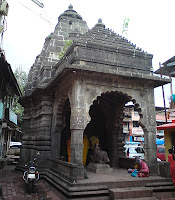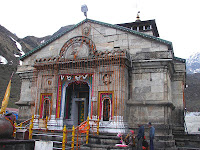Vaidyanath:
This
jyotirlinga is situated in the Santhal district of current Jharkhand. This is
the only place where the Jyotirlinga and Shaktipeeth, both lie side by side.
In
Purana we come across a line “paralyam vaidhyanatham cha”, which points this
jyotirlinga to be located at Parligram. The temple is situated above a hill
here and is an ancient one. But according to Shiv Purana, the ancient
Shivpurana tells about Vidhyanath being situated at Deoghar, Jharkhand. (The
shivlinga at Baijnath Himachal Pradesh is also said to be a part of this very
jyotirlinga and is associated with Ravana)
Vidhyanathavtaro
hi navamastak kirtit
Avirbhuto
ravanartham bahulilakar prabhu
Tadanyanrupam
hi vyajam kritva maheshwar
Jyotirlingaswarupen
chitabhumou pratishthita
Vidhyanatheswaro
namna prasidhdho bhujjagatreye
Darshanat
pujanadhbhakya Bhaktimuktipradah sa hi.
These
lines in Shivpurana tell the location of this jyotirlingam to be at “Chittabhumou”.
The Parligram jyotirlinga does not meet the criteria of being chittabhumou, but
on the other hand Deoghar is Chittabhumi. So we can say logically that the
jyotirlinga at Deoghar is the original one.
This
jyotirlinga at Deoghar also is a shaktipeeth. Part of sati’s heart had fallen
off here. This is the only jyotirlinga temple where we find them both.
Story
goes that after Asur Raj Ravana’s hard penance and his offering the head 10
times, Lord Shiva showed himself. Ravana asked Shiva that he be allowed to take
the Linga to Lanka. Shiva agreed but on condition that if he keeps it down
anywhere on way, it’ll stay there. On his way back Lankeshwar stopped at
Santhal paraganas and asked one aahir to hold it while he went off to call of
nature. The linga being heavy, the aahir kept it down on earth. Ravana could
not pick it up anymore so left. Lord Vishnu, Indra and Brahma and other Gods
came down and did puja to this linga. Thus the linga came to be placed here.
Bhimashankar:
There
is lot of debate with regards to Bhimashankar jyotirlinga temple. There is one
at Puna which is also called as Daakini. But in Kashipur too there is a
Bhimashankar temple, in ancient times Kashipur was called as Daakini, and this
temple is known as Sri Moteshwar Mahadev. Sahyadri range in Maharashtra also
has one. But according to Shivpurana, it’s the Jyotirlinga at Guwahati which is
the original one.
It is
said that Kumbhakarna has a son Bhim, who when got to know about his father’s
death, got very angry with Vishnu. He decided to teach all a lesson so started
penances. Brahma was happy and blessed him with victory. He now first took all
Gods into captivity and then fought with Vishnu to gain victory over the Lord.
He became the kig of devlok. Kamrup during that period had Sudakshin as the
King who was a great devote of Lord Shiva. Bhim took him also into captivity. The
Gods, Sages and Rishis decided to pray to Lord Shiva and the Lord assured them
of helping against Bhim. In the meanwhile King Sudakshan decided to pray to
Lord Shiva, so inside the prison itself he makes a shivlinga and starts
praying. Bhim saw this and in anger attacked the shivlinga with his sword. Lord
Shiva arises from the Linga itself and his anger itself burns to ashes the
asura Bhim. On request from all other Gods and sages, Lord Shiva agrees to be
there in the form of Jyotirlinga.
Rameshwaram:
This
jyotirlinga is located in Tamilnadu. It is said that this linga was established
by Lord Rama himself. The temple also has the Lord of Rama pillar. On his way
to Lanka Lord Rama made a shivlinga out of sand and did the puja. When he
reached this point, he felt thirsty and decided to drink water. While doing so
he heard a voice saying how come you drink water without offering me any prayer?
He then made this Shivling and prayed to Lord Shiva, who in turn blessed Lord
Rama with victory. The temple has in all 24 wells inside. Water in these wells is
sweet and drinkable. There are wells outside the temple premesis too but there
water is not worth drinking. Puranas say Lord Rama created these wells using
arrows and his power to bring water from different “Tirtha” places. They are
named also like Ramtirtha, Amritvatika, Hanuman kunda, Brahmahatya Tirtha, and
so on.
Nageshwar:
There
is lot of dispute with the location of this jyotirlinga. Some feel it’s at
Hingoli, Maharashtra in a place called Naagnath. While there is a view which
says it’s located at Jaageshwar in Uttarakhand. Among all this disputes, most
still consider jyotirlinga located at Dwaraka in Gujarat is the correct one.
There
was a very pious man Supriyo. He was a devotee of Lord Shiva. Daruk, an asur
did not like this devotion and one day attacked him and all others who were
Shiva devotee. He kept them all in prison. Supriyo carried on with his Shiv
aradhana even in the prison with his fellow prisoners. Daruk got angrier and
finally ordered his men to kill them all. Supriyo was hardly affected; he
prayed to the Lord and requested him to save all. Lord Shiva appeared before
him in the prison cell itself sitting on a big throne beautifully adorned. He
gave the Pashupat weapon to Supriyo and daruk with his followers were all
killed. On Lord Shivas order itself, this linga was named Nageshwar.
The
current temple was built by Late Gulshan Kumar. In the front of the temple you can
see a large statue of Lord Shiva sitting. This statue can be seen from almost
more than 2km distance. Inside you first arrive at a sabhagraha. Below this
sabhagraha is the Grabha griha where the jyotirlinga is placed.
Vishvanath:
This
is located at Benaras/Varanasi and popularly known as Kashi Vishvanath. This
temple is considered one of the most sacred temples. In puranas it is mentioned
that Lord Vishnu prayed to Lord Shiva in this city. Even Agastya rishi prayed
to Lord Shiva here. On the North of this city is Omkarkhand. On south is
Kedarkhand while centre lays the Vishveshwarkhand. The Vishvanath jyotirling is
placed here in Vishveshwarkhand.
According
to puranas, after Lord Shiva got married to Goddess Parvati, he was living at
Mount Kailash. One day Parvati told the Lord that every girl after marriage
goes to her husband’s house. But here she has to live at her father’s place
itself. So Lord Shiva took her to Benaras and thus the jyotirlinga came to
existence here.
Trimbakeshwar:
This
is located at Nasik in Maharashtra. Legend says, once wives of many rishis
living with gautam Rishi were unhappy with his wife Ahilya. They requested
their husbands to see Gautam rishi and his wife are thrown out from that place.
The rishis agreed to and prayed to Lord Ganesha. When the Lord came before
them, the rishis asked him to help with Gautam rishi affair. Lord Ganesha tried
his best to make them see light but to no avail. So finally he promised them
help. He turned himself into a weak cow and entered rishi Gautam’s ashram. The
rishi took a grass strand and tried to keep the cow away but instead the cow
fell dead. Gautam rishi was quite surprised. But he had to face the wrath of
other rishis for killing cow and committing sin and leave the area. But the
rishis did not leave him alone even there. Finally Gautam rishi asked them how he
can repent for the sin. They told him two ways and among them he went for one whereby
he had to make a crore shivlings and pray. Lord Shiva was pleased with Gautam
rishi and appeared before him. The rishi asked for forgiveness to which then
Shiva told him how he was tricked and those other rishis who did the same would
now face his wrath. To this Rishi Gautam requested Lord Shiva to forgive them
as because of them he could get the Lord’s darshan. On the request of all other
rishis who were present then, Lord Shiva agreed to stay in that place as
jyotirlinga.




Kedarnath:
Rameshwaram
being the southernmost jyotirlinga, Kedarnath is the northernmost Jyotirlinga.
The temple is situated atop the mountain Kedar in the Himalayas. One the west
side of Kedar flows the Mandakini River, and on its bank is placed Kedareshwar.
On its east side flows Alakananda river, and in this river’s bank is the sacred
Badrinath temple. Both the river flow down to meet Rudraprayag which in turn
meets the Ganges. So when we touch Ganga water, we get to touch the water
coming from the feet of Kedareshwar and Badrinath.
According
to purana legend, ages back two very devoted people Srinar and Narayan decied
to do penance to please Lord Shiva. For years they carried on with sadhana and
finally Lord appeared before them. Both were ecstatic. On Lord Shiva’s command
to ask for anything they want, both requested the Lord to stay there in Kedar
and help humanity in spiritual Journey. The Lord agreed to and Kedarnath
jyotirlinga came into being.
Grishneshwar:
This
jyotirlinga is located at Verulgaon in Maharashtra very near to Ellora caves.
The scared place is also known as Ghushmeshwar. It is known by many names,
Grishneshwar, Ghushmeshwar, Ghushrineshwar.
On
Devgiri mount lived a very pious brahman Sudharma with his wife Sudeha. They
wanted a child but got to know Sudeha cannot have any. So Sudeha forced her
husband to get married to her sister Ghushma. They had a son soon. Ghushma was
very pious and devote of Lord Shiva. She would make 101 shivlingas daily, do
puja and immerse them in their pond. With time Sudeha’s mind turned poisonous
and she started feeling left out in the family. One night she killed the boy
and threw his body in the pond where Ghushma used to immerse the shivlingas
after puja. Next morning everyone was heartbroken but Ghushma was unaffected.
She did her usual puja and immersed the lingas in the pond. A she turned back
to go home, her son walked out of the pond. Lord Shiva also appeared and
blessed Ghushma. He decided to punish Sudeha but Ghushma requested him to
forgive her elder sister. On Ghushma’s request he stayed back there as
jyotirlinga.







































